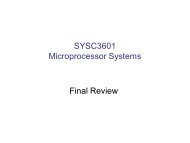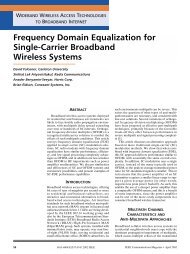Image Reconstruction for 3D Lung Imaging - Department of Systems ...
Image Reconstruction for 3D Lung Imaging - Department of Systems ...
Image Reconstruction for 3D Lung Imaging - Department of Systems ...
You also want an ePaper? Increase the reach of your titles
YUMPU automatically turns print PDFs into web optimized ePapers that Google loves.
<strong>of</strong> reconstructions were calculated <strong>for</strong> each <strong>of</strong> the seven EP configurations in which<br />
AWG noise was added in six steps from 0.1% to 0.6% <strong>of</strong> the difference signal, z. The<br />
ability <strong>of</strong> each EP configuration to reconstruct images in the presence <strong>of</strong> this noise<br />
was then compared in terms <strong>of</strong> the FOMs described earlier.<br />
8. Immunity to systematic electrode placement errors. Two techniques were used to<br />
evaluate electrode position errors.<br />
(a) In the first technique reconstructions were per<strong>for</strong>med with a systematic electrode<br />
position error in which data collected with one <strong>of</strong> the EP configurations<br />
were reconstructed using the same electrode sequence but with the lower plane<br />
<strong>of</strong> electrodes rotated by half the inter-electrode distance (Offset-Error). Thus<br />
in this first case data generated with the Planar EP configuration were reconstructed<br />
using the Planar-Offset EP configuration. This is shown in figure 6.4<br />
direction A. In the second case data generated with the Planar-Offset EP configuration<br />
were reconstructed using the Planar EP configuration. This is shown<br />
in figure 6.4 direction B. In the case <strong>of</strong> pulmonary imaging this error simulates<br />
a twisting <strong>of</strong> the thorax.<br />
A<br />
B<br />
Figure 6.4: Offset Error. Direction A: Data observed with aligned arrangement were reconstructed<br />
with <strong>of</strong>fset arrangement. Direction B: Data observed with <strong>of</strong>fset arrangement were<br />
reconstructed with aligned arrangement<br />
(b) In the second technique an Electrode Plane Separation Error was evaluated as<br />
follows: For each EP configuration 9 sets <strong>of</strong> data were simulated with the distance<br />
between the electrode planes increasing from the correct separation <strong>of</strong> 11cm, to<br />
a layer separation <strong>of</strong> 20cm. Each set was comprised <strong>of</strong> homogenous reference<br />
frame and 28 data frames generated with a small target as in section 6.2.3. Each<br />
<strong>of</strong> 9 data sets per EP configuration was then reconstructed on the same mesh<br />
geometry but always with the electrodes at the interplanar distance <strong>of</strong> 11cm.<br />
This simulates a systematic electrode placement error in which the reconstruction<br />
model does not match the actual electrode placement <strong>for</strong> 8 <strong>of</strong> the 9 simulated<br />
data sets. In the case <strong>of</strong> pulmonary imaging this error simulates an inaccurate<br />
application <strong>of</strong> the electrodes.<br />
6.3 Results<br />
In this section, we compare each EP strategy against each figure <strong>of</strong> merit, in order to<br />
differentiate amongst the per<strong>for</strong>mance <strong>of</strong> the various EP configurations.<br />
84





